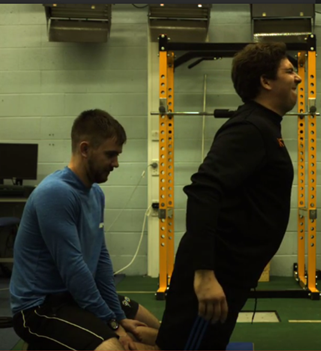Posted on January 21, 2016 by Jenny Cromack
Hamstring injuries are one of the most common in running, sprinting, and sport involving deceleration and kicking (think football). The hamstrings are often imbalanced in relation the the quadriceps, this occurs due to the nature of the two groups naturally. i.e the quadriceps are pennated and larger, whereas the hamstrings are fusiform and smaller in muscle volume. The hamstrings can thus produce greater velocity due to fibre length but sacrifice force production. Whereas the quadriceps shortening velocity is less than that of the hamstring it is capable of producing significantly greater peak force outputs.
Research seems to suggest that hamstring tears and injuries seem to occur at the extreme ends of the muscle and when contraction occurs during muscle lengthening. Think slowing down the leg during a kicking action, or the leg swing during sprinting. Combine this with the fact that the average individual has poor flexibility in the hamstrings due to anterior (quad) dominance and we have the perfect storm for hamstring injuries.
Another possible explanation for hamstring injuries seems to lay in the glute muscles. Research through EMG data has suggested that poor glute strength in relation to lower limb strength causes an irregular recruitment pattern in which the hamstrings are used to assist the glutes more frequently. This further compounds the issue of weak glutes and further stress upon the hamstrings.
Three key things therefore need to happen in the avoidance of hamstring injuries:
- The hamstrings need to be trained (ECCENTRICALLY) with perfect form
- The hamstring muscle group must be stretched (every 1 degree of inflexibility from the supine 90 degree position increases the likelihood of a hamstring tear in sport by 1.47%)
- Develop glute strength and improve the activation of the glutes
When we look at training the hamstrings we must bear in mind that injuries tend to occur at the proximal and distal ends of the muscle. We must therefore train these areas of the hamstring. The nordic hamstring curl is an excellent exercise to develop hamstring strength in the shortened position, however as velocity increases (due to gravity) the fuisform muscle is unable to to meet the force demands and peak EMG data declines.
This leaves us with the distal portion of the hamstring. Further research has shown that although eccentric contractions are less that that of concentric in relation to peak EMG, the Romanian deadlift shows an excellent profile for strength development during the end of the eccentric phase. It may also be a good exercise to help develop flexibility and muscle pattern activation.
Both exercises must be included to help protect against hamstring injuries as they enhance different parameters of the length tension relationship of the hamstring.
Glute exercises should initially be isolated as the hamstrings can dominate and may fail to allow for significant recruitment of the actual glute muscles. Unweighted glute bridges, abduction variations (clams), hip extension exercises with stiff leg etc should form the initial core of programs. Once you are capable of contraction and using you glute muscles progress to further compound exercises, such as lunge variations and weighted glute bridges where the hamstring and glute can be trained safely in tandem.
Nobody likes a hamstring injury, it can put you out of training for weeks or even months. Follow the above tips and lower your chance of suffering from hamstring injuries.


